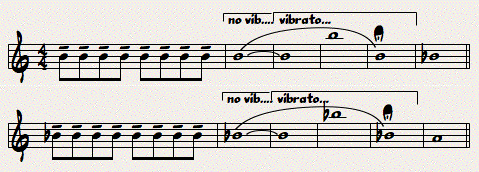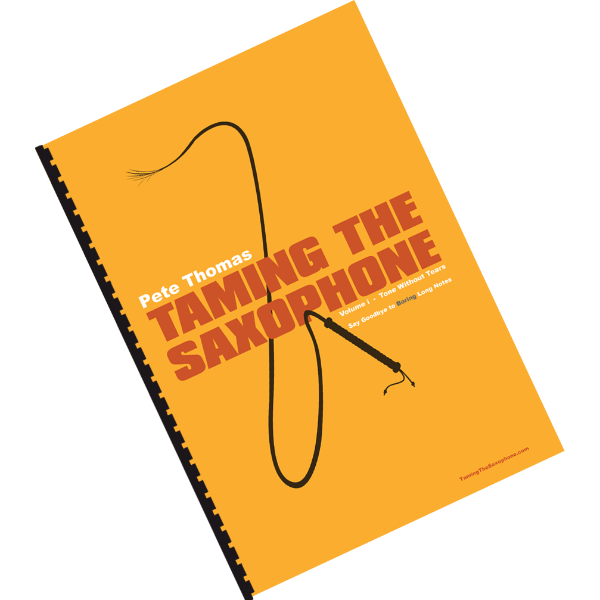Improving your saxophone tone (or sound) for more expression
First of all you may wonder why I say saxophone tone or sound. Aren’t they both the same thing?
Well, yes and no. People (including myself) do use the terms interchangeably. However I find it useful to think of a difference:
- Tone: you can think of this as the “raw” unprocessed sound made when you blow into a saxophone. It can be scientifically measured in terms of harmonics or frequencies.
- Sound: this is the end result after you have added a little personal magic to make it more personal, characterful, or expressive. This can be a specific vibrato, changes of pitch, dynamics and articulation. Or adding effects such as growl, airyness etc
Ideally you will have both. An expressive (and possibly personal) sound that is built on a solid foundation of a good well controlled tone. Control is the key. If you can control your tone, you are on the way to developing a great sound. More about the differences between tone & sound here.
How do you learn to improve your tone?
I am often asked what is the best way to get a good tone (or sound) on the saxophone. The usual answer is “practise lots of long notes”. Some people find long note playing so boring that they are unable to concentrate and so they just play long notes while thinking about something else. This kind of practice may have some slight benefit, but unless you are concentrating on what you are practising, you will be missing most of the real benefit and not achieve real tone control.
Exercises for Tone & Sound
Most saxophone players aim for a sound that is either what is accepted as a good sound
for a particular style, or else a unique and personal sound, sometimes with a combination of the two. There are two main ways to help you get a great saxophone sound:
- You need the right instrument and mouthpiece for the sound you are aiming for
- You need plenty of focussed long note practice. This sounds very boring, but it will pay off whether you are after a particular sound.
In all the following exercises the sound should be started and stopped by the tip of the tongue on the tip if the reed, the throat should be open (as if yawning) so that there is always air pressure in the mouth and throat – see Diaphragm Breathing. When the tongue is released from the reed you should imagine a clean start to the note, as if singing either a “tu” or “du”. When the note is stopped with the tongue, it should be a clean precise stop. Neither the start nor end should be louder or quieter than the rest of the note. Imagine the sound as a long straight horizontal cylinder with a vertical disc at the beginning and end

Tone exercises are not the most exciting things to play, and it’s important that you concentrate on the sound you are making, so it’s a good idea to take a break or practice something else once your mind starts wandering.
Once you have got a decent core sound, you will benefit from the more advanced saxophone tone control exercises below, which will help you with getting more flexibility and expression into your sound.
- Basic Long Notes: Try to keep the note as straight and steady as possible, no wobbles, hiccups or vibrato. Use a keyboard or tuner to check intonation if you like.
- Play a B (1st finger left hand lower register) and hold as long as possible without losing the note or getting out of breath
- Repeat on the next note down chromatically until you get to low Bb (or the lowest note you have learnt)
- Go back to the B and repeat the process up to top F (or the highest note you have learnt), or higher if to practice altissimo.
If you have not yet learnt all the fingerings for the chromatic scale you can use a major or minor scale. If you don’t have enough time on your practice session you can use a whole tone scale, in which case the next time you practice start on a Bb.
- Long Notes with dynamics This is the same as above except that the notes start quietly, increase in loudness then decrease, or else you can start loud, get quiet, then loud again. If you like, use a slow count to make sure that the crescendo and decrescendo are even.It’s important to concentrate on the tuning; there is a tendency to blow flat as you get louder.
More advanced tone control exercises
We looked at very basic long note exercises, and you may want to move on very quickly to these more in-depth and much more interesting ways to develop a great sound.
Elsewhere I have mentioned a way to help this with the page on visualising the sound, but now we are going to look at a set of very disciplined exercises which should help in many areas of tone production, as well as not being as boring and hard to keep focussed as merely playing long notes. These exercises address three areas of tone production (and with, that very valuable musical commodity: expressiveness. Practising pure long notes will help with your basic core sound, but these will add just that extra little bit of magic that makes the difference between a good sound and a great sound.
For all exercises I chose the note B to start on as it is a comfortable note near the centre of the range. Work up from the B as high as you can, then start again at B and work downwards.
- Articulation
- Vibrato (being able to “turn it on or off”)
- Slurring up/down octaves
Articulation
A note about articulation
Another reason I bang on about legato tonguing is that as well as helping with your perceived tone due to a nice beginning to the note, the ability to practise runs or scales using legato tonguing on every note will help you keep a good even timing, as the tongue has a tendency to be more regular in regards to tempo than your fingers. Even if the phrase will eventually be played legato, practising it with your tongue will really help with the accuracy and precision of the note timing.
You may have heard it said that the way you start a note has a big effect on the way your sound is perceived. When learning articulation you will see I emphasise the use of legato or soft tonguing. One of the hardest aspects of tonguing is to use it effectively but subtly. The tongue is used to make the note start cleanly, but most players find it very difficult to tongue a note without the tongue sound being very obvious, either too explosive: sometimes more of a noise than a musical note.
Before doing this exerciseI suggest you first read the page on articulation. In the exercises here do not think of separate notes, think of one long note but with just the lightest possible touch or flick of your tongue at regular intervals. If possible try to use the tip of your tongue on or as near as possible to the tip of the reed.
I suggest you try this at around 90 beats per minute, use a metronome, tap your foot or just count to yourself. Once you are comfortable at that tempo, try it faster or slower.
Ex 1 Transition from legato tonguing to (vibratoless) long notes:

Vibrato
(And What if I don’t like Vibrato as part of my Tone?)
There are people who believe that the use of vibrato is corny. Of course it can be when used in a corny fashion (e.g. a very fast wide constant “nanny goat” style vibrato), but nearly all (non-classical) players, past and present, use vibrato to quite some extent. As with singers, the vibrato can be a continuous part of the tone or else it can creep in towards the end of a note – and this is the important thing – being able to turn the vibrato on and off smoothly. Again, before doing this you should have first practised vibrato!
Again, I suggest you start this at around 90 beats per minute, but practise it at other tempos, faster and slower. The vibrato should be at the same tempo as the legato tongued notes, ie quavers (1/8 notes), and you should be able to vary the depth of the vibrato..
Ex 2 Transition from vibratoless to vibrato:

Slurring Octaves and Other Intervals
You might be wondering what this has to do with tone production. It serves two purposes. First, it will help to focus your mind on playing the octaves in tune, you should listen at for the “centre” of the sound and every time try to hear a good in tune octave. Second, it will help you with transitions from one pitch to another. In fact, there is no reason why you need to stick to octaves, try other intervals as well.
Ex 3 Slurring up/down an octave:

Of course once you can do these easily in one breath, then you can play the long (combined) version above and repeat some of the sections, eg. novib – vib – novib – vib then slur up the octave. Or else slur up – down – up – down. Basically, you can adapt this to whatever works well for you, for example you could try slurring up and down a perfect fifth instead of an octave.
Putting it all Together – The Combined Exercise
I believe if you master this exercise, you will be well on the way to developing a great sound with a good core tone and articulation plus tasteful and controlled vibrato. You may have noticed there are no dynamic markings. I do not want to force too much on you at once, but of course it would be useful to try not only different dynamics, but also try varying the dynamics through the exercise.

Was This Article Useful?
If you have any feedback or queries on this article please join this discussion thread on the Cafesaxophone forum.
If you have enough breath, you could also repeat any of the individual transitions within the combined exercise. Always make sure that as you finish the exercise, try to hold the note right to the end of your breath but without weakening – this requires good diaphragm control.
Note that at the end I have included a note one semitone lower. This is optional, but is useful when proceeding with this exercise in downward steps. The slur into the lower not prepares you for the next note. Of course, when you have reached the bottom Bb, you can then proceed upwards. In this case raise the last note. When you play this note, try to hear the tone as being the same, even though the pitch has changed. This helps you get a smooth transition of tone between all pitches.




